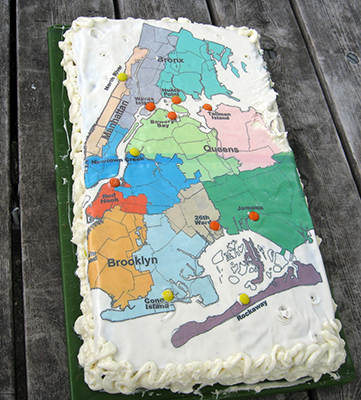


If we think about the city as an extension of the human body, then infrastructure like wastewater treatment is part of a natural cycle of “input and output”. However the geography and economy of waste are much removed from out actual bodies. The Sludge Economy makes more visible the infrastructure of human waste –specifially sewage treatment plants; and the social, environmental, and racial justice issues that are sometimes equally as invisible as the physical infrastructure.
A newsprint pamphlet outlines a sewage chronology and related social justice issues in two neighborhoods burdened by sewage treatment
plants. I also held a public event titled This Picnic Stinks! in the Riverbank State Park which sits atop the North River wastewater treatment plant in Harlem, New York City. This potluck picnic included a talk by me and Jaime Stein (formerly the environmental policy analyst at Sustainable South Bronx) about New York City’s sludge economy. A cake printed with locations of sewage plants was a visual aid and dessert.
Related projects:
> The Sludge Economy (video)
> A Bay View, SOMArts, San Francisco 2014
Exhibited:
+ Undercurrents: Experimental Ecosytems in Recent Art | 5.27-6.19.10 | The Kitchen, NYC
> Tracing Waste | 2.23-3.15.2015 | Princeton University-School of Architecture Gallery
Press/Published:
+Undercurrents (Catalog). Anik Fournier, Michelle Y. Lim, Amanda Parmer, Robert Wuife. (Whitney Museum of American Art)
> Heroes and Charlatans blog | Stephen Zacks
+ Critical Day Trips: Tourism and Land-Based Practice | Sarah Kanouse in Critical Landscapes, Emily Eliza Scott, Kristen Swenson, Eds. (University of California Press, 2015)
> Undercurrents Makes an Ecological Museum of New York City | The Indypendent